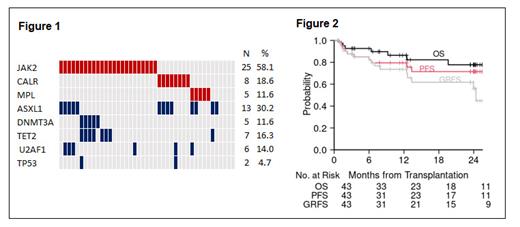Background:
Despite tremendous progress in the treatment of myelofibrosis in the last decade, the only curative therapy remains allogeneic hematopoietic cell transplantation (HCT). There are now three FDA-approved JAK inhibitors (JAKi) to treat symptomatic splenomegaly and constitutional symptoms in myelofibrosis, although these agents do not prevent disease progression. Discontinuation of JAKi before (pre) HCT is challenging as patients can experience return of symptoms. Thus, ruxolitinib is often continued during HCT in an off-label fashion; however, little is known about the safety and efficacy of this approach. Furthermore, there is increasing use of ruxolitinib after (post) HCT, following its approval in treating refractory graft-versus-host disease (GVHD).
Methods:
We previously reported the interim results of a phase II, multicenter, investigator-initiated trial investigating ruxolitinib given pre-, during- and for 1-year post-HCT for patients with primary or secondary MF (NCT03427866). Here we present the results of the study with full accrual of 43 patients. The primary endpoint was 1-year GVHD-free, relapse-free survival (GRFS). Secondary endpoints included overall (OS) and progression free survival (PFS), engraftment, and incidence of acute and chronic GVHD. Patients were treated with reduced intensity conditioning with fludarabine (30mg/m 2/d x 5 days) and melphalan (100 or 140mg/m 2 x 1). Patients received peripheral blood stem cell grafts from either 7/8 or 8/8 HLA-matched donors. GVHD prophylaxis consisted of standard tacrolimus and methotrexate.
Results:
44 patients with myelofibrosis were enrolled and 43 underwent HCT between 9/2018 and 5/2023. Median age was 66 (range 46-75), 37% were female (n=16), and most patients had DIPSS intermediate-2/high risk (n=36), 60% (n=27) were receiving ruxolitinib prior to enrolling on the study. Most (n=35) received 8/8 matched unrelated transplants and had measurable splenomegaly by either ultrasound or CT (n=40) prior to HCT. At baseline, 25 patients had JAK2 mutation, 8 had CALR and 5 had MPL mutations, 13 patients had ASXL1 mutations (Figure 1). No differences in outcomes were observed by pre-HCT mutational status. At day 100, all but one patient had undetectable mutations by next generation sequencing.
The most common grade 3/4 hematologic adverse events (AE) were anemia (n=12), thrombocytopenia (14), neutropenia (n=11). Non-hematologic grade 3/4 events included hypertriglyceridemia (n=3).
Median time to neutrophil engraftment was 15 days (range 4-38), one patient did not engraft. Median time to platelet (>20x10 9) engraftment was 25 days (range 11-145). At day 30, 2 patients had a donor-cell chimerism below 90% (one ultimately relapsed) and at day 100, 2 patients had chimerism below 90 (one ultimately relapsed). With a median follow up among survivors of 13 months (range 0.7 - 26), 1-year GRFS was 74%. OS, PFS and cumulative incidence of NRM and disease relapse were, 86%, 79%, 10%, and 10%, respectively (Figure 2). The cumulative incidence of grade III-IV acute GVHD at 6 months was 2.4%. Only one patient had grade IV acute GVHD. One year moderate/severe chronic GVHD was 11%In univariable analysis, thrombocytopenia of <40 x 10 9/L pre-HCT was associated with worse OS (1-yr OS: 64% vs 92%, p=0.008). Splenomegaly (defined as >17 cm) was associated with worse PFS (1-yr PFS: 100% vs 64%, p=0.046). There was an improvement in OS in patients that received ruxolitinib and achieved response pre-HCT compared to those that did not but this did not achieve statistical significance (1-yr OS 100% vs 74%, p=0.054).
Discussion:
This study is the first, multicenter trial to test ruxolitinib use pre-, during- and post-HCT in patients with myelofibrosis. Our results demonstrate safety and feasibility of this approach. Favorable rates of engraftment were observed with ongoing ruxolitinib administration even through hematopoietic nadir. We continue to demonstrate favorable outcomes of PFS, OS and GRFS with a low incidence of severe acute and chronic GVHD. Our results strongly support the use of ruxolitinib in the peri- and post-transplant setting for patients with myelofibrosis undergoing HCT.
OffLabel Disclosure:
Hobbs:BMS: Membership on an entity's Board of Directors or advisory committees; Incyte: Research Funding; Keros: Membership on an entity's Board of Directors or advisory committees; Pharmaxis: Membership on an entity's Board of Directors or advisory committees; Pfizer: Membership on an entity's Board of Directors or advisory committees; Morphosys: Membership on an entity's Board of Directors or advisory committees, Research Funding; Novartis: Membership on an entity's Board of Directors or advisory committees; Protagonist: Membership on an entity's Board of Directors or advisory committees; Regeneron: Current holder of stock options in a privately-held company; Abbvie: Membership on an entity's Board of Directors or advisory committees. Schroeder:Incyte: Honoraria; Novo nordisk: Consultancy; GSK: Consultancy; Kura: Membership on an entity's Board of Directors or advisory committees; Sorrento therapeutics: Membership on an entity's Board of Directors or advisory committees; Marker Therapeutics: Membership on an entity's Board of Directors or advisory committees. Wall:CTI: Speakers Bureau; Abbvie, BMS: Honoraria. El-Jawahri:Incyte Corporation: Consultancy; Novartis: Consultancy; GSK: Consultancy. Mullally:PharmaEssentia, Incyte: Other: Steering Committee ; Constellation, Protagonist: Other: Advisory Board ; AOP Health: Speakers Bureau; Aclaris, Cellarity, Morphic, Biomarin: Consultancy; Relay, Morphic: Research Funding.
The clinical trial includes an FDA approved agent, ruxolitinib, utilized in a new way (after allogeneic stem cell transplantation), but this was the sole purpose of the trial.


This feature is available to Subscribers Only
Sign In or Create an Account Close Modal